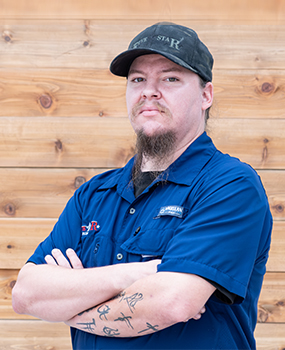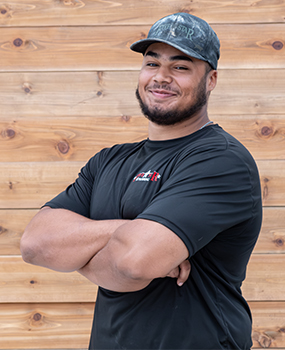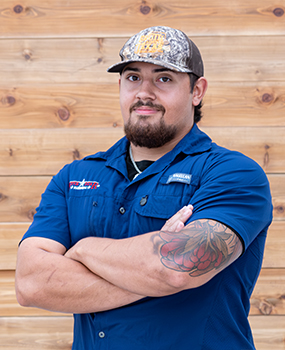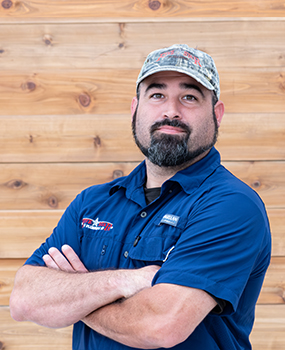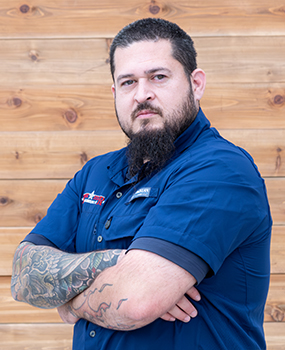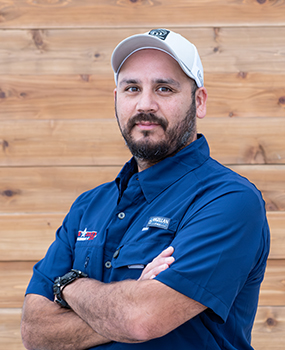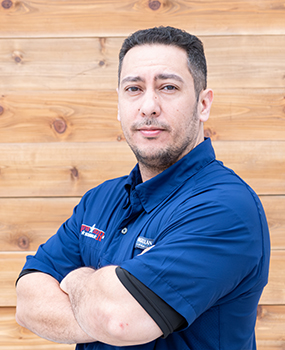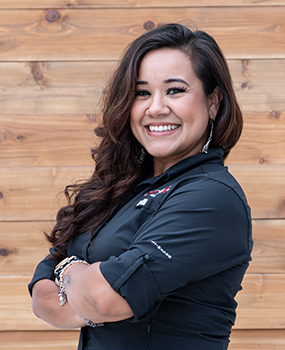If you’ve noticed signs of water (suspicious dust patterns or water stains), the next step is to locate where the water came from.
First, find some type of paper–paper towel, paper bag, newspaper. Leave it in the spot where you suspect a leak and check on it periodically to see if you can spot signs of water. You can even use a little ink on the paper so it will be easier to notice.
Next, check for appliances or supply lines in the area and examine them for tears, unattached hoses, or other signs of damage. It helps to turn the water on and off at this point, waiting for telltale drips. If you don’t notice an obvious drip, the leak could be slow. Try checking the spot daily or every few days to make sure there’s no evidence of a leak.
Once you identify the leak, you can fix it yourself or hire a professional. Also, even if you don’t find evidence but you suspect a leak, try calling a licensed plumber for a thorough evaluation of the area.
Get a gallon bucket (at least one gallon is needed to effectively move water through the toilet bowl) and fill it with whatever wastewater you intend to use. When you want to flush the toilet, simply pour the water into the toilet bowl. There’s no need to push the handle or worry with the tank lid. Gravity does all the work for you.
An escutcheon refers to the metal piece that hides the unsightly hole in wall where the pipe pokes through. It is also called a flange or cover plate. You’ll mostly see them on the wall or ceiling around the shower arm, the water shutoff valve (by the toilet), under the sink, and at the base of certain faucets.
If you notice rust or other signs of damage on an escutcheon, replacement is fairly simple. You’ll need to shut off the water and let the lines drain by turning on a few faucets and waiting until they go dry. Then, remove the valve covering the escutcheon that needs replacing, catching any excess water in a pan or cup. You’ll need pliers and a little force to get it loose in most cases, and it helps to use a towel with the pliers so they don’t damage the valve. Once you see the escutcheon, remove it and put on the new one. You can then replace the shutoff valve and turn the water back on.
Plumbing code describes the best practices for all plumbing installations. It protects public health and safety by maintaining strict guidelines for any plumbing work in private and public dwellings, and each state, city and county might have distinct codes for operating in that district. Plumbers typically use the UPC (Universal Plumbing Code) designed by the International Association of Plumbing and Mechanical Officials (IAPMO), which gets updated every few years to include new knowledge and technology.
Before they receive a license, plumbers must go before an executing board and demonstrate certain skills. When you use a licensed plumber, you know you are hiring someone with a foundation of knowledge and experience who will observe all proper guidelines and procedures. Although anyone with a certain skill set can perform plumbing work, you risk endangering yourself and the public if you entrust plumbing tasks to anyone not willing to or capable of following code.
Gas hot water heaters should sit at least 18″ off the floor to provide adequate air intake (combustible fumes sink).
Once you remove the overflow plate, you can put a snake down a tub drain. If you’re not sure how to identify the overflow plate, it’s the round element on the tub wall that has two screws. When you remove it, two pieces of the stopper will come out with it. In most cases, hair or other buildup on this component has caused the clog, and a snake might not be needed.
In many cases, what you think is a tub leak is actually damaged grout or a bad pan beneath the shower. The difference between this situation and a tub leak can be determined by how the water drips. A constant leak generally indicates pressurized water lines. A periodic leak, on the other hand, often points to worn grout or other issue. In either case, consider having a licensed plumber perform a thorough check. If a leak is found, you can have it fixed and if not, there’s no need to worry.
A leak at the base of the toilet usually points to a faulty flange. First, check to ensure it sits flush with the floor. If the flange sits too low, use two wax rings–a regular one on the bottom and one with a plastic horn insert on the top. You can also check that the glued flange is secured. If the glue doesn’t stick (or no glue was used), re-glue it and see if that stops the leak.
If your faucet only drips when you turn on another one or flush the toilet, it usually means you have a loose washer, since pressure keeps the washer in place when no water runs but lets it rise when other water is in use.
Before diagnosing a leak caused by water pressure, make sure all parts of the toilet work properly. If, however, you’re certain the water pressure causes it to leak past the toilet fill valve, you need a pressure-reducing valve to remedy the issue. If you think you have high water pressure, don’t neglect getting a water pressure regulator, since washing machines, pipes, connectors, and water heaters can leak or break when water pressure is too high.
You have two choices here:
First, you can look for the cleanout plug (a small, rectangular, brass box). You might be able to unscrew it, but if not, try cutting off the square with a Sawzall before making cuts from the center to the threads (like you’re slicing pie). Next, peel the plug away from the female threads (it should be 3″) and replace it with a 3″ male adapter.
To go another route, you’ll have to remove a section of pipe by cutting it with a Sawzall or snapping it with a cast iron ratchet cutter. If you do this, make sure the upper section of pipe is well-supported. Otherwise, it could come crashing down.
In most cases, a vent shouldn’t cause a drain to back up, but it’s not impossible. Although drains work without a vent, plumbing code directs all fixtures to be vented.
A clunk in a drain pipe almost always indicates a loose washer. To fix the problem, simply replace the old washer with a new one. Note: Make sure the screw comes out with the old washer. If it doesn’t, you’ll need to turn the water on to flush the screw out.
An unused drain will dry out and get rough around the inside. Although using it again will sometimes clean up the issue, prevention works better. Running water through unused drains every so often will keep them from drying out.
If you notice low plumbing fixtures (toilets, bathtub/shower drains) overflowing when other fixtures drain, it usually means you need to pump the septic tank, or an outside sewer pipe is damaged/broken. It could also mean the primary drain has a clog. In rare cases, the wastewater from the washing machine ties into the soil or waste line of another fixture. When this happens, water rushes by the suds (at a high velocity) and pushes ahead. Because the low fixture offers closer refuge, the suds come up into it. To prevent this from happening, plumbing code requires a kitchen sink, washing machine, shower, and dishwasher line to connect at least 5′ downstream from all fixture branches.
Whatever the case, if you have this problem, you should hire a licensed plumber to come in and repair the lines.
You can’t. It’s illegal to connect any ground or rainwater to a sewer line or septic tank. Not to mention, it’s environmentally and plumbing-wise unsound.
If drain pipes under the sink keep coming loose, you might have a material-mixing issue. For example, PVC washers could be mixed with metal nuts and washers. In this area, all pipes should fit down into the next pipe as deeply as possible, and materials should match (metal pipes get metal nuts, etc.).
It is. Replacing a bathtub is no small task. To make it easier, you can get tub surrounds that come in two or three pieces (to make fitting through the door simpler). Also, consider replacing the shower faucet and waste/overflow mechanisms when you replace the tub.
This used to happen a while back because of poor galvanizing practices. These days, galvanized pipe presents little threat. However, most plumbers choose to use black pipe with natural gas, since it usually costs less. Also, if you use galvanized pipe for water, black pipe will distinguish between the two. If you must use galvanized pipe for everything, you might paint one a certain color. You don’t want to mistake a water pipe for a gas one.
At the end of each cycle, dishwashers should have a little water in the bottom to prevent the element heater (needed for drying dishes) from burning up.
It helps to check the code for this one because certain states don’t allow steel gas unions inside buildings. Instead, there should be left and right hand couplings and nipples. Note: No sealant is necessary on union faces, since a seal comes from female and male surfaces.
Most experts recommend copper pipes, unless you have aggressive water or low pH. This preference comes from plastic’s tendency to become brittle and sag over time. To repair a damaged plastic pipe, you’ll need glue, and you won’t have access to water until the glue dries. Also, mice and other critters love to chew plastic.
In general, plumbers use two fixtures on a half-inch pipe. It also doesn’t hurt to run three-quarter-inch pipe for each fixture. To size a water distribution system, you’ll need a copy of your state’s code, which will spell out all appropriate guidelines, including pressure, furthest fixture from the meter, and quantity of fixtures in the house.
Note: Jobs like this aren’t easy DIYs; it helps to have a licensed plumber.
Moving water is less likely to freeze, so it always helps to let a faucet (or two) drip when freezing temperatures set in. You can also put an incandescent light bulb in the well house (be sure not to use fluorescent). Simply put it near the pump and leave it on in frigid weather. It heats the space nicely, though make sure it can’t fall over and light something on fire.
You could also go the prevention route and make sure (before cold weather strikes) there are no broken windows, drafty holes, or missing insulation. You can weatherize the well house by applying heat tape to pipes, installing weather-stripping, adding calk, and repairing the roof. If there’s no insulation, you can install it or use a thermostat-controlled space heater.











